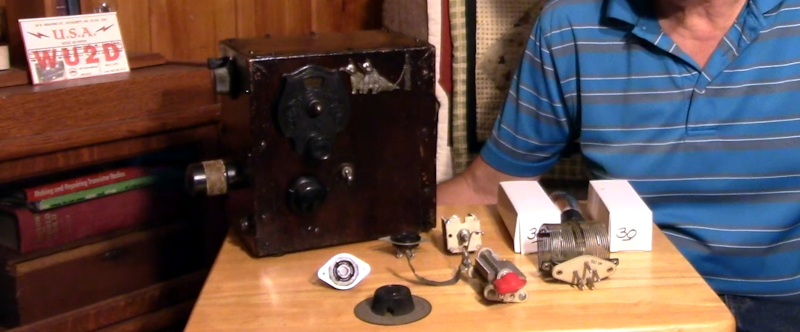[Mikrowave1] wanted to build an authentic 1930s-style ham radio station that was portable. He’s already done a regenerative receiver, but now he’s starting on a tube transmitter that runs on batteries. He’s settled on a popular design for the time, a Jones push-pull transmitter. Despite the tubes, it will only put out a few watts, which is probably good for the batteries which, at the time, wouldn’t have been like modern batteries. You can see the kickoff video below.
According to the video, these kinds of radios were popular with expeditions to exotic parts of the world. He takes a nostalgic look back at some of the radios and antennas used in some of those expeditions.
The Jones oscillator originates with [Frank Jones, W6AJF] and was quite popular in the day, as he was well-known in ham radio circles then. Normally, these took a dual triode and a crystal along with some passive components. In this case, though, the transmitter will use two type 30 tubes. If you missed the series on the receiver, that’ll give you something to watch while you wait for the next installment on the transmitter.
We are excited to see — and maybe hear — this station on the air. Of course, you can build simple gear today, too. You can only wonder what [Frank Jones] would think of modern software-defined radios.
















There was a memorial “museum” of sorts called “Scotts Hut” that was the original structure. It is full of artifacts from the expedition. Not sure if there was a radio or not. But lots of food containers… Not sure if it still exists today… Very interesting article.. Thanks
Here is what Frank Jones MIIGHT have said about SDR receivers:
“I like the 12mc IF.” he continued, ” No trouble with images and you can introduce regeneration at this 12SG7 for
selectivity and beat note. There are the makings of a pretty good rig here,” he said as he began to put the tools in a roll-up
pouch so understatedly elegant no biker would be seen with it. “What is the IF of your receiver?”
“First one at about 45 and second at 455, I said,” assuming a Drake SSR-1 follows the modern pattern.
“Really?,” he said, “Where did you get the 45 mc IF cans?”
“I didn’t, I said, It’s a …”
“Wait a minute,” he snapped. “You have a STORE BOUGHT receiver?”
“Yea, It’s a…”
“Don’t even tell me, ” he ordered as he tucked the leather roll under his arm and the Valkaries began to ride. He looked me
in the eye and said: “Would you hire someone else to lay with your wife?”
I would have taken offense but, in truth, the first one entertained volunteers and, besides, he continued to develop his thesis:
“The receiver is the most important part of the station. If you have to choose, run a store bought transmitter, but Never, I
mean Never depend on anyone else to design and build your receiver…not even McMurdo Silver”
I think Frank would consider SDR gear to be store-bought gear.
Fiction, but believable fiction. From: https://tomf.home.blog/wp-content/uploads/2019/12/frank_and_the_fmla.pdf
So he was the original Sad HAM, then? ;)
I love to see people undertaking projects like this! many congratulations, hope to see much more of this station and this creator on the web! 73 de ac4rd
This is a really interesting project, making it truly portable is a unique goal, and I hope to work him with that station!
There is a video on YouTube of a really well built 1930s era Field Day station in action, constructed by NO3M. Definitely worth a look if this sort of thing interests you :
https://youtu.be/2w8F5K90xXI?feature=shared
Wow, thanks man! I love the 19″ rack idea. It fits nicely! 😃 vy73s
What’s also cool, the morse telegraphy signals in the video sound a bit like those of old, ex-soviet era stations.
You know, that squeaky sound.. Probably due to the homebrew power supply..
Without strong stabilizing condensers it’s just normal that the power breaks down a bit during transmission.
“You can only wonder what [Frank Jones] would think of modern software-defined radios.”
In reality? After about half a year he would have had adopted to our society and technology.
Same goes for most historical figures, I think. Their intellect is (was) above that of the average citizen of today. They may miss their time, though, and feel depressed about what culture has become.
Nice.
I’ve built a few tube regenerative shortwave receivers, but still hoping to tackle a matching transmitter. (and get the ham licence). These tube circuits are like haiku: so much function for so few components.
If you want to hear what the ham radio bands sounded like in the 1940s, the following sound clip from a phonographic record will delight:
http://www.crossbandradio.com/xbands/ehams.mp3
The bands were much quieter in those days, much less radio interference compared to the shortwave bands of today that are filled with crackles and chirps! It is fortunate such a recording has survived.
Radio Riley here…looking for Buddy Brandon, Snap Allen and Corky…